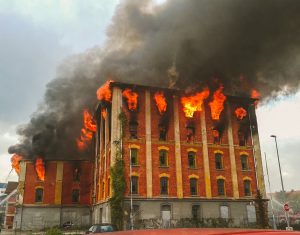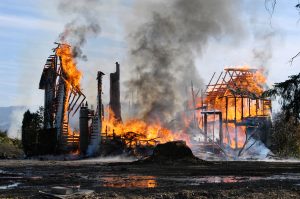Most types of real property can be insured on either of the following bases:
 Replacement Cost is the current cost of constructing the building on the same site with materials of like kind and quality and for like occupancy without deduction for depreciation. More simply put, it is the current cost of replacing the present building with a new one.
Replacement Cost is the current cost of constructing the building on the same site with materials of like kind and quality and for like occupancy without deduction for depreciation. More simply put, it is the current cost of replacing the present building with a new one.
Actual Cash Value has been interpreted by the courts to mean two different things and one insurer advised us that attempting to define it was “analogous to nailing jelly to a wall”. Unless it unduly penalises the insured, the courts usually interpret Actual Cash Value as the fair Market Value of the building. Market Value is the price the property would bring on the open market if sold by a willing seller to a willing buyer. The land value has to be deducted from the market value of the property to isolate the value of the building.
Actual Cash Value may be computed by the three standard valuation methods, i.e. the Direct Sales Comparison, Income and Cost Approaches. In a perfect world, all three would give the same answer. The Cost Approach consists of calculating the Replacement Cost (new) of the building and deducting therefrom the physical depreciation, functional and external (locational) obsolescence. A substantial minority of court decisions have arrived at Actual Cash Value by deducting only physical depreciation.
Since 98% of fire losses are only partial losses, it would be possible to underinsure a property, knowing full well that there was little chance of loss in excess of the insured value. Co-insurance is a device to discourage this practice and is used by insurance companies to limit their own liability. Thus, the insurance company will not compensate the owner of a property who suffers a partial fire loss, the full amount of that loss, even if the loss is less than the insured value, unless he carried insurance at least equal to the co-insurance requirement. If, for example, a property having an actual cash value of $1 million, insured for $0.7 million, under a contract containing an 80% co-insurance clause, suffered a $0.5 million partial fire loss, the total insurance actually paid to the property owner would then be:
$700,000 x $500,000 = $437,500
80% x $1,000,000
If the prospect of bearing part of the loss fails to fill you with enthusiasm you should file a statement of value with your insurer. The statement should be backed up by a professional appraisal and this too should be filed with your insurance company. It is then unlikely to be challenged if you subsequently have a claim. You can also purchase “inflation protection” which will insure the buildings (but not your process equipment) against rising costs, based on the Statistics Canada Non-Residential Construction Price Index (for commercial property). You should update your insurance whenever you make major changes, and at least every five years. If you don’t have inflation protection, update it annually. This is relatively inexpensive since we hold the original specifications on file.
You should also purchase a “Building By-Laws” endorsement to cover additional costs imposed by by-laws, regulations or ordinances of law. For example, you may be required to demolish or render safe and sightly the fire damaged portion of the building immediately … well in advance of your reconstruction work. This insurance endorsement will not cover you if the zoning by-law prohibits reconstruction of the building because it is a non-conforming use. Quite often buildings no longer meet the municipal zoning by-law because the allowable uses, set back, or height requirements have changed since the building was originally constructed. If you cannot rebuild, your insurance will only compensate you on an Actual Cash Value basis …
Some buildings and much machinery may not be replaceable, often because technology has rendered it obsolete. In the case of a machine being replaced by a more modern equivalent, for example an obsolete computer with a current model, compensation will be assessed on the Replacement Cost of the current model, or the insured value, whichever is the lesser cost. However if the manufacturing process has so changed that you cannot replicate it, the insurer will only pay on an Actual Cash Value basis. The compensation is unlikely to fund your world cruise, much less put you back in business. However, not to despair there is a solution: you can purchase a Functional Replacement Cost Endorsement. This allows you to replace the fire-damaged property with a “better” machine or building … provided of course that you have sufficient insurance coverage to fund the cost.
If you don’t intend, or cannot, replace the building or machinery you will be compensated on an Actual Cash Value basis. At first blanch this suggests that you insure on this basis under these circumstances, to save on the premium. However by doing so, you expose yourself to the risk of having insufficient coverage under the co-insurance clause unless you have a complete fire loss.

Although only 2% of fires result in a total loss, damage from fire, smoke and water often render it difficult to establish the state of the building before the fire. The original architectural plans and specifications are usually no longer available because they have been destroyed, often in the fire. Property owners should therefore keep a description of their building, together with photographs and plans, in a safe place off the premises.
We offer the following fire insurance services:
Building Inventory – This can be undertaken most cost effectively in conjunction with our Lasercad® measurement service. The building inventory records all of the floor, wall and ceiling finishes in each major space, plus the plumbing, heating, airconditioning, electrical, elevators, fixed equipment and fire protection installations. Together with our “as built” Lasercad® plans it provides the property owner with a good record of the building. We supply the building owner with two copies of the report and maintain the original in our own files.
Fire Insurance Valuation – This can be undertaken most cost effectively on any property on which we have given valuation or appraisal advice, since we will have already collected most of the factual data.
Our valuation reports for fire insurance include colour photographs of the exterior, together with a comprehensive description of each building. The latter includes a description of the exterior and interior, including floor, wall and ceiling finishes, plumbing, heating, air conditioning, electrical, sprinkler system, fire protection, elevators and fixed equipment.
The valuation section of the report can address either the Replacement Cost or Actual Cash Value, depending on the specific requirements of your insurance policy. We utilise a computerised costing system to calculate the replacement cost (new) of a wide variety of building types. It employs the Unit in Place method for buildings other than small residential properties. The latter are valued on the computer by the Comparative Method.
Insurance companies usually require a professional valuation if the building is to be insured on a Replacement Cost basis.
Update Valuations – We hold details of each building “on file” in our system. This enables us to update the valuation whenever current replacement costs are required. This is particularly useful for fire insurance valuations since we can arrange for these updated costs to be provided automatically at specified intervals.